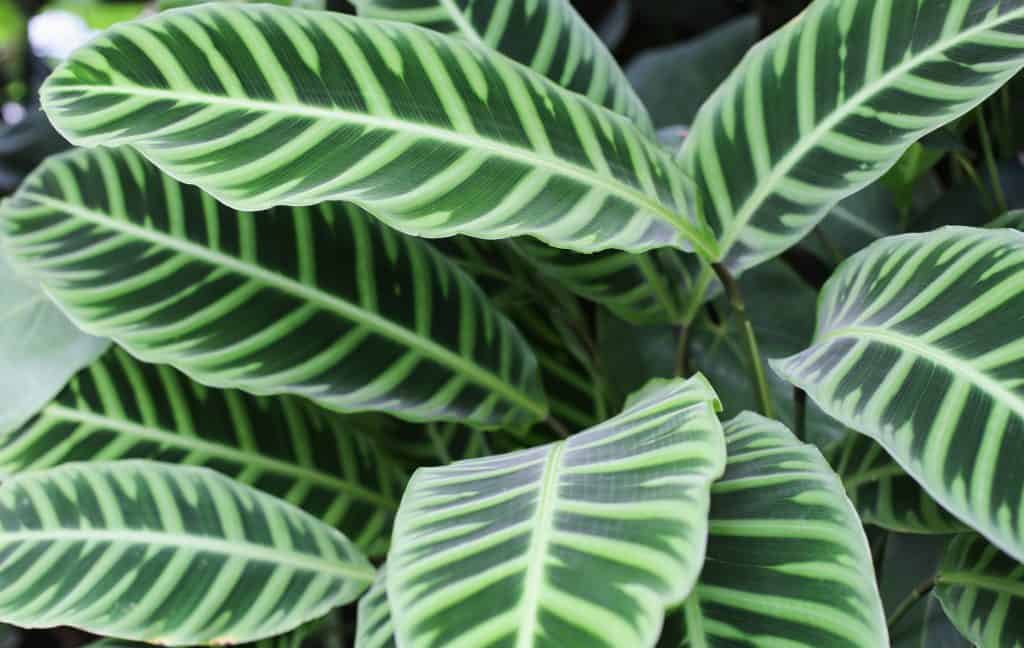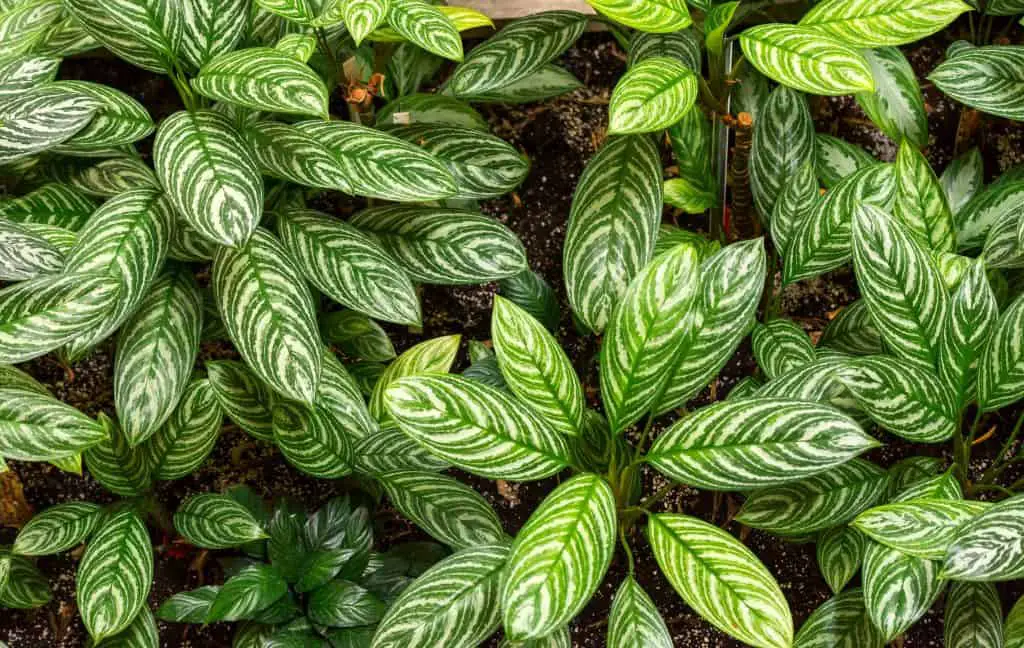If you’re interested in an indoor plant that is going to give you striking foliage, you won’t go wrong with the Calathea zebrina, or the zebra plant. This tropical plant is native to Brazil. Its natural habitat is the dense forest where it is shaded by trees and does not receive direct sunlight. This rhizomatous, compact evergreen perennial features large, velvety, dark green, ovate leaves at the tip of a long stalk. The leaves have darker green stripes that extend from the mid-veins to the leaf margins, giving it the zebra-stripe appearance. There is a contrasting reddish-purple underside. The leaves of this plant are the main attraction as they do, in fact, resemble zebra stripes, hence the name zebra plant. At dusk, the leaves fold together and resemble praying hands, which is why it is sometimes called a prayer plant.
Besides the striking ornamental leaves and the gorgeous visual display this plant offers, there are many benefits to having this plant as part of your indoor garden. This plant is active at night and works to purify the air. Where many plants stop photosynthesis at night, this plant continues to use light, water, and carbon dioxide to create oxygen and energy. It takes in carbon dioxide at night and releases oxygen, increasing the O2 concentration in the air and acting as a natural air purifier. It also helps remove toxins, such as dust. The large, waxy leaves trap dust particles, helping keep your air and home free of dust. Just wipe the leaves to clean the dust off.
Additionally, the zebra plant removes formaldehyde and benzene from the environment. Formaldehyde is known to cause eye, nose, and throat irritation and can cause skin rashes and respiratory issues. Benzene can damage the immune system and can cause anemia.
The zebra plant is a natural moisturizer, trapping moisture and then using some and releasing some. This helps with dry skin issues and respiratory issues. The zebra plant also helps decrease depression and stress symptoms, in addition to helping improve blood pressure and heart rate.
This plant is part of the Marantaceae family. It is also known as Aphelandra squarrosa, Maranta pulchella, Phrynium bicolor, Maranta bicolor, Calathea binoti Gentil, Maranta zebrina, Phrynium zebrinum, Endocodon zebrina, Goeppertia zebrina, and as the prayer plant.

Calathea Zebrina Care
The Calathea zebrina is fairly easy to care for, though it does have some specific requirements that need to be met in order to help it thrive.
Outside, the Calathea zebrina requires filtered light, shelter from strong winds and extreme temperatures, and the right watering conditions. A greenhouse or a shaded, warm spot is the ideal location outdoors. It grows best in USDA hardiness zones 11-12. In its natural environment, the zebra plant can grow to be 6 feet tall and 5 feet wide. The leaves on this plant are a robust 9 to 15 inches in length. It will grow fast in the right soil and lighting conditions.
As an indoor plant, you will rarely see the white-to-purple blooms this plant is capable of. However, it will thrive indoors for many years with the right care. It is a slow-growing plant when indoors and reaches maturity of approximately 2 feet in about 3 years’ time.
The perfect indoor conditions for the zebra plant are good humidity level, consistent soil moisture, a warm temperature, and no direct sunlight. It is important to keep the soil well drained and the home temperature between 65 to 75 degrees Fahrenheit and no lower than 60 degrees Fahrenheit. Avoid temperature drops and drafts. It does best in indirect sunlight, and full sun in the heat of the afternoon should be avoided. However, it will tolerate morning or diffused sunlight. The bathroom is the ideal place for this plant because of the increased humidity and the good lighting. With too much or too little light, this plant will lose its beautiful color, and it can also die as a result of improper lighting.
The key to a thriving and beautiful zebra plant is to keep the growing conditions balanced. This plant requires a warm, shaded spot and a moist environment. If indoors, it needs to be placed somewhere without a cold draft because it needs that moderate warm temperature for optimal growth and health. Filtered lighting is best as direct sunlight will scorch the leaves. Ideally, it should receive five hours of sunlight daily.
Keeping the humidity level right is important for the plant to be healthy and flourish. It needs high humidity to grow, and there are several ways this can be accomplished. You can use a humidifier to put extra moisture into the air, or you can mist the plant to humidify it, misting from the bottom to avoid too much moisture on new leaves. You also should not spray directly on the leaves. Interestingly, you can also keep it near other plants. Plants release moisture through their leaves. This is called transpiration. When plants are grouped together, it creates a more humid microclimate, which benefits all of your plants.
Zebra plants love rich soil. A peat-based mix of two parts peat to one part Perlite is a good mixture. If you prefer a ready-made potting mix, African Violet potting mixture is a suitable choice, or you can use equal parts garden soil and Perlite or sand with peat.
The Calathea zebrina may require a fertilizer if you want to see robust growth. You can provide a standard liquid fertilizer during the growing season, which is April to October, giving your plant weekly or bimonthly feedings. Always fertilize after watering. You should not fertilize during the winter months because winter is a time when many plants are dormant and in a resting state. The days get shorter, and there is less light, which means there is less growth. Therefore, the plants need less fertilizer.

Zebra plants need plenty of water during the growing season. It experiences the best growth when it has moist soil with good drainage. Allowing the plant to sit in water can lead to root rot.
During the winter months, when growth slows or stops, you should reduce watering and let the topsoil dry out between watering. Use water that is room temperature. Cold or saline water may make your plant sick, so use distilled water or tepid rainwater. Hard water, or water that is heavy with minerals and chemicals, can cause scale buildup and water stains, which can lead to wilting.
Repotting Calathea zebrina
The best time to repot Calathea zebrina is when it outgrows the pot it is in or when you are ready to multiply your plants. However, it is good to repot the zebra plant at least every two years during spring.
Propagating the zebra plant is easy and effortless. At the time of repotting, divide the main plant. Provide a warm environment and enough humidity after dividing the plant and after replanting.
You can also use leaf cuttings or baby plants to propagate. Pull the young plants from the stem of the plant and plant in new pots. The roots will grow in 4 to 6 weeks.
Planting seeds is another way to propagate, and this can be done by sowing them in a pot with peat moss. Cover the seeds with soil and water gently. Keep in indirect sunlight and a warm environment. The seeds will sprout in a few weeks. When they are larger, transplant to containers.
Transplanting the zebra should be done during growing season, which is mid-spring to late fall. Be sure to water well during and after potting. Use a quality soil mix, but do not use too much soil as it may hold water and lead to root rot. Move the plant as quickly as possible without disturbing the roots. Be sure to transplant in the late afternoon or evening in order to minimize shock to the plant.
For pruning, do this only if the stalk or leaves are damaged or infected. Do not prune healthy leaves and stems.
Calathea zebrina Common Pests and Diseases
As with any plant, Calathea zebrina can be susceptible to many types of problems, pests, or diseases.
Leaf curling and spots: This is typically due to underwatering. Simply check for soil dryness and water.
Yellow leaves: Yellow leaves are a sign that your plant is receiving too little water. To remedy this, make sure your potting mix is appropriate and maintain soil moisture.
Brown leaf tips: If your zebra plant leaf tips look dry and brown, this means the air quality is dry. Increase the humidity, and this should correct the problem.
Leaves dropping: If the plant leaves start to drop, this is a sign the air is too dry. Increase the humidity. Mist the plant or group it with other plants.
Limp stems: Limp stems are a sign of too much water during winter or a temperature that is too low. Decrease water and increase temperature. Remember, this plant likes well-drained soil and a warm environment. Make sure you have enough drainage holes in your container so the water drains good.
Drooping leaves: Drooping leaves mean your temperature is too cold and the conditions are too dry. Water your plant to keep the soil moist, and increase the temperature to a warm 65-75 degrees Fahrenheit.
Gray mold: If you find mold on your zebra plant, this means there is too much humidity. Remove the infected leaves and place the plant in a well-ventilated area.
The zebra plant is generally a pest-free plant. However, it can sometimes be affected by aphids, spiders, mites, or mealybugs. If you notice any pests, treat with neem oil or insecticide spray.
Is Calathea Zebrina Safe for Pets and Humans?
The Calathea zebrina is safe for pets and children. However, the sap from the plant may irritate the skin of people with allergic tendencies or skin sensitivities. There are no thorns on this plant, and this plant does not secrete any toxic chemicals.
Where to Find Calathea Zebrina for Sale?
You can buy Calathea zebrina at places like Home Depot, Lowe’s, or Walmart, or any store that has a garden center. You can also find them online at places like Etsy, Amazon, Planterina, or americanplantexchange.com. Prices range from $12.99 to $65, depending on the size of the plant.
Overall, this plant is a gardener’s favorite because of its appearance. With the right care, it can be one of the most attractive and striking indoor plants aesthetically and can also provide many health benefits. It is a plant that keeps on giving as long as it is well cared for.
